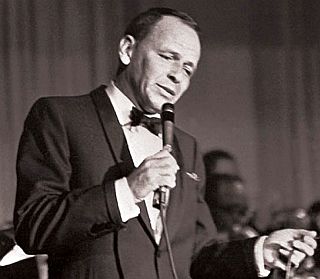
1966: Frank Sinatra performing at The Sands nightclub, lost in a moment of song -- perhaps grieving over that lost summer love...
“Summer Wind” has a poignancy about it that is tailor-made for Sinatra. It’s a story about a summer love, once held, but now gone and wistfully and longingly remembered by its crooning narrator.
The song’s musical treatment, plus Sinatra’s delivery, give it a presence in the mind’s eye; transporting the listener to a summer place, summoning the very elements of that season.
One guest writer at the Sinatra Family Forum website – “Melissa” – put it aptly in her 2006 comment: “Summer Wind was meant for Frank Sinatra. No one has ever done it better. I can almost feel the breeze blow when he sings it.” Indeed, the “summery-by-the-ocean” feel is there through and through.
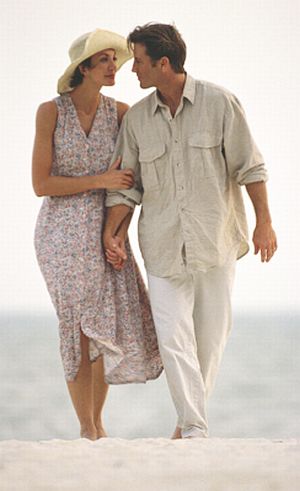
Anonymous couple enjoying a summer beach stroll.
Music Player
Summer Wind – 1966
Frank Sinatra
Sinatra recorded his version in mid-May 1966 with Nelson Riddle and his orchestra. The song was released later that same month on the album, Strangers In The Night. It also appeared as a Reprise single backed by “You Make Me Feel So Young” on the B-side. By the week of August 30th, WABC radio of New York had “Summer Wind” as a top hit prospect. Beginning in early September 1966 the song would have a seven-week run on the Billboard pop singles chart, peaking at No. 25. “Summer Wind” also hit No. 1 on the Easy Listening chart in October that year.
Although “Summer Wind” is classic Sinatra in style and content, he didn’t start performing it regularly at his concerts until some twenty years after its recording. But by 1986, “Summer Wind” had become a part of Sinatra’s performances.
|
“Summer Wind” The summer wind, came blowin’ in, Like painted kites, those days and nights, The autumn wind, and the winter winds, The summer wind; warm summer wind |
A Summer Love
The male narrator of “Summer Wind” remembers a happy time – a brief time, with his summer love. He sings of strolling on the beach, and glorious days and nights, shared between the two. The listener can imagine all of the good summertime activity that a couple in love could share – from dinner at a seaside café and evening walks along the shore, to the deeper intimacy and personal discovery that come with romantic relationships.
“The world was new,” the narrator sings, clearly taken with his lady and seeing only good things ahead. He was feeling like a million bucks, and more. Anything was possible!
But then, suddenly, it all ends.
Turns out, the summer wind can cut both ways.
One day it called to the lady of this lyrical tale, sending her off for parts unknown; no explanation offered. The narrator simply croons, “I lost you to the summer wind.” Was it another love? A rooted and committed life somewhere else? Or perhaps it was personal: some fundamental differences? No details provided.
In any case, those formerly happy days and warm summer nights were now just a memory. Closing his eyes, our narrator is there again, back in that moment, remembering how it was, though heartsick in the losing. Going forward, he nurses his hurt through the “autumn wind” and the “winter wind” – harsher times, and lonely times — longing for a return to that earlier time, left only with “my fickle friend, the summer wind.”
Millions of music listeners have had their own “summer wind” experiences, good and bad, and Frank takes them along for the ride in this song. It’s just good, old-fashioned “memory music,” tinged with a touch of the blues made perfect by the master.
The song and lyrics of “Summer Wind,” however, are flexible enough that the song has been used in other contexts, some commercial. “Summer Wind” was used in the opening scene of the 1984 film, The Pope of Greenwich Village, starring Mickey Rourke and Darryl Hannah. It was also used in the 2003 film Matchstick Men with Nicolas Cage and Alison Lohman.
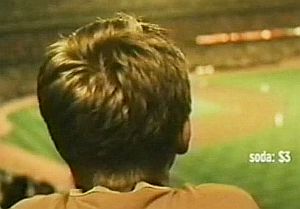
Frame from MasterCard TV ad, "Family of Four - Summer Wind," depicting a family at an L.A. Dodgers baseball game away from modern distractions. Click to view ad.
At The Ballpark
In 2006, MasterCard used the song in a baseball-themed TV ad depicting a family outing at a big league game. The ad was part of MasterCard’s “priceless” commercials, and was shot at Dodger Stadium in Los Angeles.
The ad features a family of four taking in a night game in the grandstands at Chavez Ravine. The sentimental spot plays up the family relaxing and bonding during the game at the ballpark, away from all the modern gadgets and distractions.
As Sinatra’s “Summer Wind” plays in the background, the voice-over in the ad states: “Program in the first: $4. Snacks in the fourth: $25. Soda at the end of the seventh: $3. No runs, hits, errors, TVs, meetings or video games — priceless.” Sinatra’s cool message, between the lines in this case, is actually saying: “Hey, relax. Chill out. Enjoy the game. Enjoy your family. Feel the breeze.” In this ad, “Summer Wind,” sets the tone, and puts the viewer in that frame.
Sinatra’s 1966
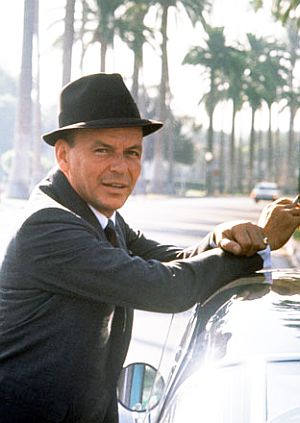
Frank Sinatra, likely in California, mid-1960s or so.
In March 1966, Moonlight Sinatra, a studio album recorded the previous November was released by Sinatra on the Reprise label. All of its songs reference the moon in some way, and it was arranged and backed by Nelson Riddle and his orchestra. The album’s title is a play on Beethoven’s “Moonlight Sonata”. In May 1966, Sinatra released Strangers in the Night, the album that included the No. 1 hit single of that name, along with “Summer Wind” and a mix of show tunes, standards and big band music.
In his personal life, meanwhile, in mid-July 1966, Sinatra married Mia Farrow. She was 21, he 50. She was then the star of TV soap opera Peyton Place. By late July 1966, the album Strangers in the Night had reached No. 1. on the Billboard 200 albums chart. The single version of “Strangers…” hit No. 1 on the U.K. charts in June 1966, and also on the Billboard pop and easy listening charts in July. Early that fall, as Sinatra and Farrow settled into their first months of marriage, “Summer Wind” was also in the Top 40 on the radio. Another Sinatra album, That’s Life, was released in October 1966, with its title song, “That’s Life,” hitting the No. 4 spot in December 1966 — this and other Sinatra hits coming at a time when the Beatles, Rolling Stones, Beach Boys, and other rock groups were all the rage.

Cover of the April 1966 issue of Esquire magazine, featuring Gay Talese’s classic article on Frank Sinatra. Click for book.
As for the title of the Gay Talese piece, the article opens in 1965 with Sinatra in a bad mood at a private Hollywood club. He is stressed about all the events in his life he is then dealing with, and on top of it all he has a common cold, which has restricted his singing.
Talese, meanwhile, proceeds to write about Sinatra mostly in 1965, the year he turned 50, when he was in the news regarding his involvement with Mia Farrow. It was also the year when he was the subject of a CBS television documentary that had pried into his personal life and speculated about possible ties to mafia leaders. Sinatra’s various business ventures in real estate, film, recording label were also probed. At the time, Talese also wrote that Sinatra maintained a personal staff of 75. Over time, however, the Talese Sinatra profile became more about Talese’s writing style and the “new journalism” methodology he employed than it was about Sinatra per se – although the subject was well covered, to be sure.

Anonymous couple catching the seaside’s summer wind.
For other Sinatra-related stories at this website, see, for example: “The Sinatra Riots, 1942-1944” (his teen idol phase at NY Paramount); “Ava Gardner, 1940s-1950s” (includes section on their relationship); “Sinatra: Cycles, 1968” (Sinatra song profile); and “The Jack Pack, 1958-1960” (Frank’s Rat Pack & John F. Kennedy). Thanks for visiting – and if you like what you find here, please make a donation to help support the research and writing at this website. Thank you. – Jack Doyle
|
Please Support Thank You |
____________________________________
Date Posted: 5 August 2015
Last Update: 22 July 2018
Comments to: jdoyle@pophistorydig.com
Article Citation:
Jack Doyle, “Summer Wind, Frank Sinatra: 1966,”
PopHistoryDig.com, August 5, 2015.
____________________________________
Sources, Links & Additional Information
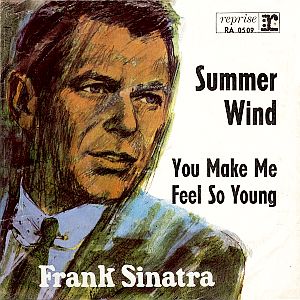
Cover art for Reprise single of Frank Sinatra's "Summer Wind," as released in some European countries, 1967.
Stephen Thomas Erlewine, Album Review, “Strangers in The Night,” AllMusic.com.
Guest Comment, Melissa, at “The Origins of “Summer Wind,” SinatraFamily.com, May 19-20, 2006.
Mark R. Gould, “Great Songs: ‘Summer Wind’ and Songwriter Johnny Mercer.”
Geoff Edgers, “Why Frank Sinatra Still Matters,” WashingtonPost.com, May 29, 2015.
“Strangers in the Night (Frank Sinatra album),” Wikipedia.org.
“Sinatra at the Sands,” Wikipedia.org.
“Moonlight Sinatra,” Wikipedia.org.
MasterCard, “Family of Four – Summer Wind,” AdWeek.com, December 19, 2007.
Gay Talese, “Frank Sinatra Has a Cold,” Esquire, April 1966.
________________________________